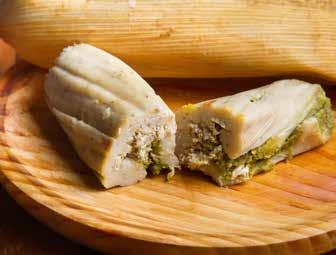
14 minute read
Tamales — Flavor and Tradition Packed in a Simple Dish
By JUlia misieGo, FaRmeRs maRket manaGeR, Utah FaRm BUReaU FedeRation
Is there anything more comforting on a chilly day than a warm, doughy, meaty tamale? As the leaves turn and fall arrives in earnest, we’re taking a look at this flavorful and versatile cuisine.
Advertisement

Tamales are a traditional Mexican dish consisting of corn flour or “masa” dough filled with sweet or savory fillings, wrapped in a corn husk or banana leaf. Many other countries in Latin America also have their type of tamale, but it is widely believed that tamales originated in Mexico.
According to history.com, the first tamales appeared as early as 7,000 B.C. in the Aztec empire, before modern maize was fully domesticated, and played an important role in religious rituals. They remain an integral food staple in religious and cultural celebrations across Latin America.

Like most ancient and traditional foods, making tamales is time and labor-intensive and was usually prepared by groups of women. Alin Olmos, the owner of Tamales Tita, a home tamale business based out of West Jordan, remembers her grandmother making tamales in her hometown of Puebla, Mexico. “Making tamales has always been a tradition in my family,” Alin said. “My grandma made everything from scratch, even the cornmeal.”
Alin said her grandma would call all the grandchildren into a line in front of the corn grinder that was attached to the table. Each grandchild would take turns grinding the corn until their arms hurt, then the next would take
over. “Then my uncles would stir the masa,” Alin said. “Masa has to be mixed a lot or else it doesn’t taste good. My grandma would drop a ball of masa into a cup of water and if it floated, it meant my uncles could stop stirring because it was finally done.”

Alin said her aunts would be in charge of wrapping the tamales, so it was truly a family affair.
“The children would grind the corn, my uncles would stir, my aunts would wrap, and my grandma created the flavor.”
After the masa is ready, it is spread onto a soaked corn husk (the husk is never eaten, it is simply used to keep the ingredients together and as a holder/plate to eat the tamale), a filling is placed in the center, and then the whole thing is wrapped together and steamed in a large pot. Because of the labor and time to make traditional tamales, it was generally a celebration food cooked when there were lots of people gathered.

“We ate them on Three Kings Day, January 6th, and on February 2nd, Candlemas Day,” Alin said.
Three Kings Day, or Día de los Reyes, celebrates the three wise men who brought gifts to the baby Jesus. Candlemas Day, or Día de la Candelaria, occurs exactly 40 days after Christmas, and celebrates the presentation of Christ at the temple and also serves as the mid-way point between the winter solstice and spring equinox.
“It was very common for us to have tamales for breakfast after a day of cooking,” Alin said. “But here in the United States, they are mostly considered lunch or dinner.”
The most popular flavors are chicken and pork, but tamale filling options are almost endless.
Alin developed a variety of savory and sweet options, including jalapeno and cheese, mole, pineapple, and sweet cream, but filling types can vary from family to family or from region to region.
Tamales likely first made their way into the present-day United States during the 1800s. According to history.com, as early as the 1870’s tamale carts were a prevalent feature of Los Angeles’ streets.
Tamales can be found in almost any country that has Spanish ties: Guatemala, Cuba, Belize, The Philippines, Guam, as well as the United States. There is even an African American fried hot tamale specialty that developed in Mississippi during the 20th Century.
Even though they can be very difficult and time-consuming to make, tamales developed a reputation for being “peasant food” in the 19th Century. But perhaps it is their humble appearance that lends to their enduring charm. They are easy to transport and eat, due to their husk wrapping, and their filling options can be adapted to almost any flavor profile or personal preference.
Tamales are increasing in popularity in Utah, and while it is very possible to make your tamales at home with a little patience and a steamer, many people leave it up to the professionals. You can find tamales in many places, from restaurants and cafeterias to farmer's markets and food trucks.
You can buy tamales fresh or frozen, and you can also freeze freshly-made tamales. There are different ways to re-heat tamales, but my personal preference is to simply place the frozen tamale in the microwave with the husk for several minutes. Others prefer reheating them in the oven, and if you buy them packaged follow the instructions on the box.
Tamales remain a traditional celebration food and are enjoyed by people from all ethnic and cultural backgrounds. Enjoy!
Using Food & Planning to Create Better Health

By JUlene reese, PUBlic relations sPecialist, UtaH state University extension
Too often, the best intentions to eat a healthy diet and become physically active are overshadowed by busy schedules, lack of motivation, and competing priorities. A healthy lifestyle is associated with many long- and short-term benefits, including reduced risk of obesity, type II diabetes, heart disease, certain cancers, improved cognitive function, mood, and weight maintenance; however, obtaining and maintaining a healthy lifestyle can be a challenge.
Utah State University Extension’s Create Better Health Utah (SNAP-Ed) program, formerly known as Food $ense, aims to help Utahns make better health a reality, regardless of location, budget, or time constraints. The program name was recently changed to more accurately reflect that its scope is broader than just food, said Casey Coombs, assistant director for Create Better Health. The program provides a variety of resources and classes on nutrition, budgeting, cooking, food safety, and physical activity.
“The purpose of the program is to teach youth and adults these skills in the locations where they eat, live, learn, work, and shop,” she said. “Our goal is to increase their knowledge of an overall healthy lifestyle, and USU Extension is in a perfect position to do that. Since we are a state-wide program with offices that serve every county in Utah, we are able to reach all corners of the state, which is a huge benefit to our program participants. We are also able to collaborate with community and statewide partners to help with resources and outreach.”
Hiram Wigant, a Create Better Health ambassador for Cache County, has worked for the program for two years and loves to see people make choices that bring them to a healthier lifestyle. He teaches nutrition education classes that encourage healthy shopping, cooking, and eating habits and also works within the community to provide resources for public health as it pertains to nutrition and hunger solutions.
Below, Wigant shares some of his favorite meal planning and shopping tips.
Meal Planning
“I often tell class participants that you can spend 10 minutes every night agonizing about what to eat or you can spend 30 minutes a week planning it all out,” Wigant said. “Why not save yourself around 40 minutes a week, not to mention the unnecessary stress. Of course, starting anything new will take a little more time, but once you get the hang of it, it becomes a speedy and even enjoyable process.”
1. Set up. Get a pen, a piece of paper, grocery advertisements, your phone, and a cookbook.
2. Take stock. Check the refrigerator and pantry for any foods that need to be used before they go bad. Plan those foods into your first meals so you don’t end up throwing them away and wasting money.
3. Fill in the blanks. Use the grocery ads to find sale items you like, and incorporate those into meals. If you need to, refer to your cookbook or online resources for recipes. Write the ingredients you need to buy on your shopping list.
4. Review. Try to incorporate the five food groups, including dairy, fruit, grains, protein, and vegetables. Add a healthy snack or side if you don’t have enough of one food group, like a bowl of fruit with breakfast or lunch, or a vegetable side with dinner.

Photos courtesy of Utah State University Extension.

list on the fridge where you can see them regularly. Add to the list as you think of things you need.
6. Take a picture. This ensures you don’t forget your list when you’re in the store. It also allows you to review past menu plans and save favorite recipes for faster planning in the future. If you use online recipes, take a screenshot. If you have a recipe book, leave color-coded sticky notes or write directly in the book, leaving a rating and any notes about the recipe.
Grocery Shopping Tips
Eat before you shop. You are less likely to buy as much on a full stomach.
Make a budget. Estimate how much it will cost to purchase the items on your list. Keep a tally of actual costs as you shop.
Bring your list and stick to it. Trust that you put enough on the list for the week when you did your planning, and stay true to it so you don’t go over budget. and you’re less likely to take time to compare prices, quantities, and nutrition facts. Also, go when you have time and aren’t in a rush.
Stick to the edges of the store. Generally speaking, fresher foods are located on the edges of the store, and processed foods are kept in the middle.
Compare brands. When you find what you’re looking for, check carefully to compare brands and sizes. Also compare the unit price or price per ounce printed on most price tags in smaller print. Compare the nutrition facts of the items.
Be flexible. Have a plan, but if something similar is cheaper, consider trying that option. If you like honey crisp apples, but gala apples are cheaper, try the gala. Variety is the spice of life!
Become a store loyalty or rewards
member. These generally require only a name, phone number, or address. They often provide extra deals and don’t cost you anything. might not be worth it. Compare the couponed item with the off-brand price.
Buy in bulk when appropriate. For nonperishable items you often use, it may be cheaper to buy larger amounts when they are on sale. These items might include canned foods, baking goods, some condiments, and other foods you use frequently.
Food Substitutions
Simple Swap. When buying canned goods, if you see a “no salt added,” “low sodium,” or “in water” option, buy that over the higher sodium, “in oil,” or “in syrup” options. (When you use the items, it is wise to rinse and drain them to eliminate excess sodium or sugar.)
Oil in baking can be replaced with an equal amount of pureed white or pinto beans and offers about 1/10 of the calories. Alternatively, ¼ cup of oil can be replaced by ½ cup applesauce or ½ cup mashed banana. These alternatives also help make the finished product moister.
VOTING – A PRICELESS AMERICAN RIGHT

By sUsan FUrner, vP consUMer engageMent, UtaH FarM BUreaU Federation
One On February 14, 1870, female citizens in Utah made history as the first to exercise women’s right to vote. A young schoolteacher named Seraph Young cast her ballot in the Salt Lake City municipal election on her way to work, becoming the first woman to vote in the Utah territory and the United States under a women's equal suffrage law. It was another 50 years before the 19th Amendment, allowing women to vote, became national law. The year 1870 also marked the passing of the 15th Amendment, granting African American men the right to vote.
The suffrage movement for women, African Americans and many others has been a longfought battle that faced setbacks and divisions. Voting rights were difficult to win, maintain, and protect.
One hundred and fifty years later, do we Americans take our privilege to vote for granted? Do we ask ourselves if our vote really matters? We can’t lose focus on the fact that voting is a priceless American right. Whether you are voting for your public servants on the school board, county commissions, city councils or the president of the United States, your vote does matter and will help to set the direction of your community, state and country.
Like consumers who do their research before making a big purchase, voters can take steps to make informed election decisions.
Know the issues that are important to you.
Think about the issues that are important to you such as education, the economy, a strong military, immigration, healthcare, religious beliefs, civil rights, or equality. After giving the issues some thought, look for a candidate that shares those values.
Look for a candidate with qualities you can support.
Research the candidates’ platforms and figure out what they plan to do while in office. Check out the candidates’ websites, watch debates, and attend townhalls so you can be sure you are voting for someone who will support your beliefs. Ask yourself what characteristics you expect in your elected officials. What qualities and experience do the candidates bring to office?
Find information from diverse sources.
Learn what other people think about the candidates. Reach out to people other than your family and like-minded friends and ask which candidate they support and why they support them. Listen to seek understanding. Ask them how they formed their political opinions. What issues are most important to them and why? Their perspective may help clarify your own opinions and views.
Learn about endorsements.
What organizations or people have given their endorsement to the candidate? Endorsements can be a clear indicator of the issues the candidate supports.
Observe the candidates’ campaigns.
Do they accept invitations to speak to a wide diversity of groups/people? Do they accept invitations to debate? Who contributes to their campaign? How knowledgeable are they on the issues?
Use critical thinking.
Think about political issues in an objective and critical way. Use your skills in observation, analysis, reflection, evaluation, problem solving and decision making to arrive at a conclusion.
All candidates use rhetoric to persuade and gain voter support. Sometimes the differences of opinions and the public dialogue is distorted and it’s hard for even the most careful and diligent voter to sift through and find the truth. But there are things to help you arrive at the truth. Try to determine how the candidates plan to accomplish their campaign promises. Check out their votes on past issues.
Find information from diverse sources. Don’t limit your research to websites, talk shows, or social media. Find outlets that seem neutral or unbiased. Research outlets representing the other side so you can consider topics from a different perspective. Use your critical thinking skills about what you read and what you choose to believe, especially if the source is from the opposing candidate.
Prepare to Vote.
Be sure your voter registration is current and if not, register to vote. Know where to cast your ballot and the dates for primary and general elections.
Stay respectful during the election season.
Show respect for those whose beliefs differ from yours. Differences of opinion is what built this great democracy. You may learn something new if you listen and engage others in the conversation. Maybe your job isn’t to persuade others to change their opinions and positions, but merely offer a different perspective for them to think about.
When sharing information on social media, be careful about what information you pass along. Make sure the information is fair, accurate, and from a reliable source. During this election season, remember those who paved the way for all of us to enjoy the right to vote. Exercise your privilege and sacred responsibility because your vote matters.
For the past 40 years, the American Farm Bureau has asked every presidential candidate to provide responses to issues likely to impact and affect farmers and ranchers and rural communities in the next four years. Both President Donald Trump and former Vice President Joe Biden have provided their answers. Those interested can find the questionnaire at https://www.fb.org/land/ presidential-candidatequestionnaire.






